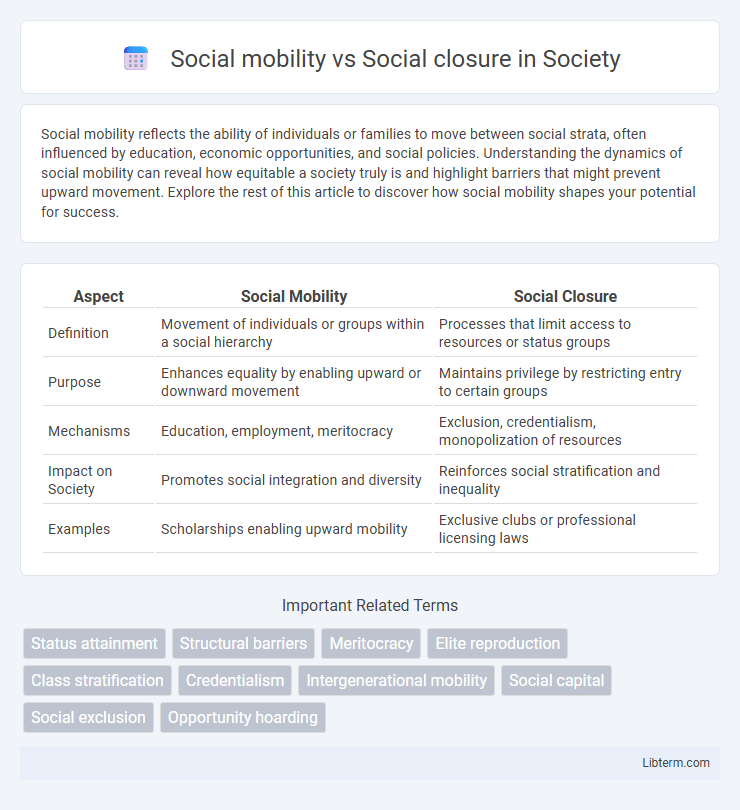Social mobility reflects the ability of individuals or families to move between social strata, often influenced by education, economic opportunities, and social policies. Understanding the dynamics of social mobility can reveal how equitable a society truly is and highlight barriers that might prevent upward movement. Explore the rest of this article to discover how social mobility shapes your potential for success.
Table of Comparison
| Aspect | Social Mobility | Social Closure |
|---|---|---|
| Definition | Movement of individuals or groups within a social hierarchy | Processes that limit access to resources or status groups |
| Purpose | Enhances equality by enabling upward or downward movement | Maintains privilege by restricting entry to certain groups |
| Mechanisms | Education, employment, meritocracy | Exclusion, credentialism, monopolization of resources |
| Impact on Society | Promotes social integration and diversity | Reinforces social stratification and inequality |
| Examples | Scholarships enabling upward mobility | Exclusive clubs or professional licensing laws |
Understanding Social Mobility: Definitions and Types
Social mobility refers to the ability of individuals or groups to move within a social hierarchy, influenced by factors such as education, occupation, and income. Types of social mobility include vertical mobility, which involves moving up or down the social ladder, and horizontal mobility, which involves changing positions within the same social level. Understanding social mobility requires examining the mechanisms that enable or restrict movement, contrasting with social closure processes that limit access to resources and opportunities to maintain group advantages.
What is Social Closure? Key Concepts Explained
Social closure is a sociological concept describing processes by which social groups maintain exclusivity and limit access to resources, opportunities, or privileges, often through mechanisms such as credentialing, social networks, or discriminatory practices. It preserves power and status within a specific group by restricting entry based on characteristics like class, ethnicity, or education. Understanding social closure is crucial for analyzing how inequality persists despite apparent social mobility opportunities.
Historical Perspectives on Social Mobility and Closure
Historical perspectives on social mobility reveal shifts in class structures influenced by economic changes, such as industrialization enabling upward movement through education and employment. Social closure, rooted in groups restricting access to resources and opportunities, often manifests in practices like guild memberships or exclusive social clubs that maintained elite power in pre-modern societies. The tension between these dynamics highlights how institutional barriers shaped the possibilities for individuals to change their social status throughout history.
Factors Influencing Social Mobility
Factors influencing social mobility include education, economic policies, and labor market dynamics, which determine the accessibility of opportunities across social strata. Social closure mechanisms, such as credentialism and exclusive networks, restrict upward mobility by limiting access to resources and positions for certain groups. Cultural capital and family background also play crucial roles in either facilitating or hindering an individual's movement within the social hierarchy.
Mechanisms and Forms of Social Closure
Social closure operates through exclusionary mechanisms such as credentialism, where access to prestigious education limits entry to elite professions, and through monopolization, where resource control restricts competing groups. Forms of social closure include exclusion, maintaining group boundaries to deny outsiders entry, and usurpation, where subordinate groups challenge and seek to access privileged positions. These mechanisms contrast with social mobility, as closure preserves existing hierarchies by controlling opportunities and resources rather than enabling upward movement.
Social Mobility vs Social Closure: Core Differences
Social mobility refers to the ability of individuals or groups to move within a social hierarchy, either upward or downward, based on factors like education, income, or occupation. Social closure, by contrast, involves mechanisms that restrict access to resources or opportunities, preserving status and privileges within certain groups through exclusionary practices. The core difference lies in social mobility promoting fluid movement across social strata, while social closure maintains rigid boundaries to protect established group advantages.
The Role of Education in Mobility and Closure
Education serves as a critical tool in enhancing social mobility by providing individuals with skills, knowledge, and credentials that increase access to higher socioeconomic statuses. Conversely, education can act as a mechanism of social closure when access to quality education is restricted by socioeconomic barriers, limiting opportunities for disadvantaged groups. The interplay between educational access and systemic inequalities significantly shapes the dynamics of social mobility and social closure within societies.
Impact of Class, Race, and Gender on Social Structure
Class, race, and gender significantly shape social mobility and social closure by influencing access to resources, opportunities, and networks within a social structure. Social closure enforces boundaries that restrict marginalized groups, reinforcing systemic inequalities and limiting upward mobility. These intersecting factors perpetuate disparities by maintaining power imbalances and restricting social integration across different social strata.
Policy Approaches to Enhance Social Mobility
Policy approaches to enhance social mobility prioritize expanding access to quality education, affordable healthcare, and equitable employment opportunities, addressing structural barriers that perpetuate social closure. Programs targeting skills training and lifelong learning foster upward mobility by equipping individuals from marginalized groups with the tools to compete in the labor market. Social mobility policies also emphasize reducing discrimination and promoting inclusive economic growth to break cycles of inherited social status and exclusion.
Future Trends: Toward an Open or Closed Society?
Future trends indicate a nuanced interplay between social mobility and social closure, where technological advancements and education access foster greater opportunities for upward movement, promoting an open society. However, persistent economic inequalities and institutional barriers reinforce social closure, limiting access to elite resources and perpetuating social stratification. Policy interventions targeting equity and inclusion remain crucial in determining whether societies evolve toward openness or entrench closed social structures.
Social mobility Infographic

 libterm.com
libterm.com